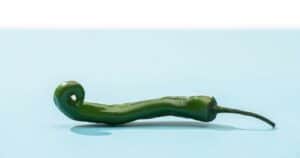As a dog owner, you likely go the extra mile to pamper your pup with tasty treats. If you’re a fan of snacking on bell peppers yourself, you may wonder – can dogs eat bell peppers too? Are sweet peppers a smart choice for dogs?
The short answer is yes, dogs can safely eat bell peppers in moderation. Both raw and cooked, bell peppers provide important vitamins, minerals, and antioxidants that support canine health. Their crunchy texture also helps clean dogs’ teeth.
However, bell peppers do contain sugar, so they should only be an occasional treat. It’s also essential to remove all seeds and introduce peppers gradually to avoid stomach upset. Don’t go overboard with bell pepper treats.
In this article, we’ll explore the nutritional benefits of bell peppers for dogs and how to incorporate them into your pup’s diet. You’ll learn about serving size recommendations based on dog size and proper preparation methods. We’ll also cover precautions to take and signs of intolerance to watch out for.
Let’s dive in and see why bell peppers deserve a spot on your dog’s list of approved healthy snacks!
An Overview of Bell Peppers for Dogs
Bell peppers come in a rainbow of fun colors like red, orange, yellow, green, and even purple. Also called sweet peppers, these crunchy vegetables have a mild, slightly sweet taste.
Both raw and cooked bell peppers are safe for dogs to eat in moderation. In fact, they offer some great nutritional value. Bell peppers are packed with antioxidants, vitamins A, C, B6, and E, plus the carotenoids lutein and zeaxanthin.
These compounds support dogs’ immune function, vision, skin, coat, bone, and brain health. Bell peppers also provide fiber to aid digestion. Just be sure to introduce them slowly and watch for any intolerance.
Benefits of Bell Peppers for Dogs
So why should you consider adding bell peppers to your pup’s diet? Here are some of the top health benefits:
- Immunity boost – With abundant vitamin C, bell peppers support dogs’ immune systems.
- Healthy skin and coat – Vitamins A and E promote skin and coat health.
- Eye health – Lutein, zeaxanthin, and vitamin A nourish dogs’ eyes.
- Dental health – Bell peppers help clean dogs’ teeth while chewing.
- Digestion aid – The fiber in bell peppers promotes healthy digestion.
- Cancer prevention – Antioxidants like vitamin C may help prevent cancer.
- Brain health – Vitamin E protects the brain and prevents cognitive decline.
Bell peppers provide a nutritious crunch that livens up any dog diet! Just be sure to introduce them gradually and avoid overfeeding.
Are Bell Peppers Safe for Dogs? Precautions
Bell peppers are safe for most dogs when introduced properly. However, there are some precautions to keep in mind:
- Remove all seeds and stem – These can cause choking hazards or intestinal blockages if swallowed.
- Introduce slowly – Start with just a bite or two to check for tolerance before increasing portion sizes.
- Avoid seasoning or cooking oils – Plain, raw peppers are healthiest for dogs. Avoid added salt, butter, or toxic seasonings like onion and garlic.
- Prevent freezer burn – Don’t feed dogs bell peppers that are mushy or damaged from the freezer.
- Avoid spoiled produce – Only feed dogs fresh, firm bell peppers free of mold and bacteria. Discard any slimy peppers right away.
- Prevent obesity – Bell peppers are healthy but high in sugar. Obese dogs should enjoy them only occasionally.
- Stay hydrated – Increase your dog’s water intake since bell peppers have high water content.
- Talk to your vet – Consult your vet before introducing new foods, especially for dogs with chronic health conditions.
With proper precautions, bell peppers make a nutritious treat! But be sure to supervise your dog anytime they enjoy a new food.
Can Dogs Eat Bell Pepper Seeds?
Bell pepper seeds are not toxic to dogs. However, they present a potential choking risk and may cause intestinal discomfort. It’s safest to remove all seeds before feeding bell peppers to dogs.
The fibrous texture and larger size of seeds make them difficult for some dogs to digest. They can pass through the digestive tract undigested and lead to constipation or diarrhea. Seeds may also get lodged in the esophagus, intestines, or rectum.
To avoid these risks, take the extra step of deseeding bell peppers before serving them to your dog. You can also grind or puree peppers with some added water to make the texture smoother and easier to digest if your dog seems sensitive.
How to Prepare Bell Peppers for Dogs
For maximum nutrition and safety, follow these tips when preparing bell peppers for your dog:
- Wash thoroughly under running water to remove dirt, debris, and bacteria.
- Remove the stem, seeds, and inner white membranes – these are tough to digest.
- Chop peppers into bite-size pieces to prevent choking.
- Lightly steam or microwave peppers to soften them before serving, if desired. Don’t overcook.
- Avoid adding any seasonings, salt, oil, or toxic ingredients like onions/garlic.
- Place prepared bell pepper pieces in a bowl of fresh water for extra hydration.
- Refrigerate unused portions within 2 hours – peppers spoil quickly at room temperature.
- Consider freezing chopped peppers in an ice cube tray for easy single-serving snacks.
Follow these tips for preparing bell pepper treats that your pup will love while avoiding potential risks!
What’s the Ideal Serving Size of Bell Peppers for Dogs?
The proper bell pepper serving for dogs depends on their size:
For small dogs:
- No more than 2-3 bites of a bell pepper
- 1-2 tbsp chopped peppers max
For medium dogs:
- 4-5 bites of a bell pepper
- 3-4 tbsp chopped peppers
For large dogs:
- No more than 1/4 bell pepper
- 5-6 tbsp chopped peppers
Remember that bell pepper sugars can cause weight gain if overfed. Start with small amounts and adjust based on your dog’s tolerance. Too many bell peppers may cause soft stools or diarrhea.
And always supervise your dog with new foods – don’t leave them unattended with a whole bell pepper, as choking could occur. Be safe and stick with bite-sized pieces!
Other Vegetables Dogs Can Eat
In addition to bell peppers, these healthy veggies make great snacks for dogs:
Carrots – Crunchy, low-calorie, and high in vitamin A.
Green beans – Provide fiber, vitamins C and K, and silicon.
Cucumbers – Hydrating and refreshing with vitamin K.
Pumpkin – Rich in fiber and vitamin A to ease digestion.
Sweet potatoes – Contain vitamin C, beta carotene, and fiber. Watch out for added sugars!
Broccoli – Packed with antioxidants and vitamin C but serve in moderation.
Asparagus – High in prebiotics to support digestion and nutrient absorption.
Zucchini – Provides hydration and vitamins A and C.
Spinach – Leafy and nutritious but introduce in small doses due to oxalates.
Rotate a variety of vegetables to give your pup all the nutritional benefits. Just be sure to introduce new veggies slowly and watch for signs of intolerance. Check with your vet before significantly changing your dog’s diet.
The Verdict: Bell Peppers Are a Nutritious Dog Treat
So can dogs eat bell peppers as a healthy treat? The verdict is yes – dogs can and should enjoy bell peppers in moderation.
Bell peppers provide important vitamins, minerals, and antioxidants that support dogs’ health. Their crunchy texture also freshens dogs’ breath while nibbling. Just be sure to remove all seeds and introduce peppers gradually.
In reasonable amounts, bell peppers are a safe and nutritious snack. They add color and variety to any dog’s diet. Mix in some carrot coins, green beans, or sweet potato wedges for a well-rounded veggie meal.
Remember to start slow with new treat foods and monitor your dog’s reaction. Make sure plenty of fresh water is available, too. If you notice any digestion issues after feeding bell peppers, hold off for a few days before trying again.
With small serving sizes and proper precautions, bell peppers can be a rewarding treat for both you and your pup. So go ahead – break out the red, orange, yellow, and green bells for a crisp, refreshing, and healthy snack you both can share and enjoy. Yum!





